What does it take for a game to stay in your collection? A clever, unique mechanism? Nice graphics? Accessibility? The downside of collecting board games and the shear volume of games being published nowadays is that it gets tough for a new game to be brought to the table, let alone get repeated plays. Take Cellulose: A Plant Cell Biology Game for example, about which I’ve written just recently. Everyone I’ve played it with had a good time and was pleasantly surprised, none had initially requested it to be played after browsing what else was on offer that night. In contrast, Furnace has a very enticing value proposition: a resource-engine-builder-auction-game that plays in 45min with good graphics. Count me in!
When I heard of Furnace, I got really excited because it hits a number of sweet spots for me. Granted, the theme is not the most original, but it makes that up with a bidding mechanism I’ve never experienced before. It has great artwork and the reasonable playing time meant that it had the chance to see the table more than once, slid in later in the evening after the main course of Kanban EV, Dune: Imperium or Barrage would be done. The hype (and probably one of the best Shut Up and Sit Down Intros ever) also helped that multiple people in my groups had a) heard of Furnace and b) where exited to try it out. So let’s see what we found!
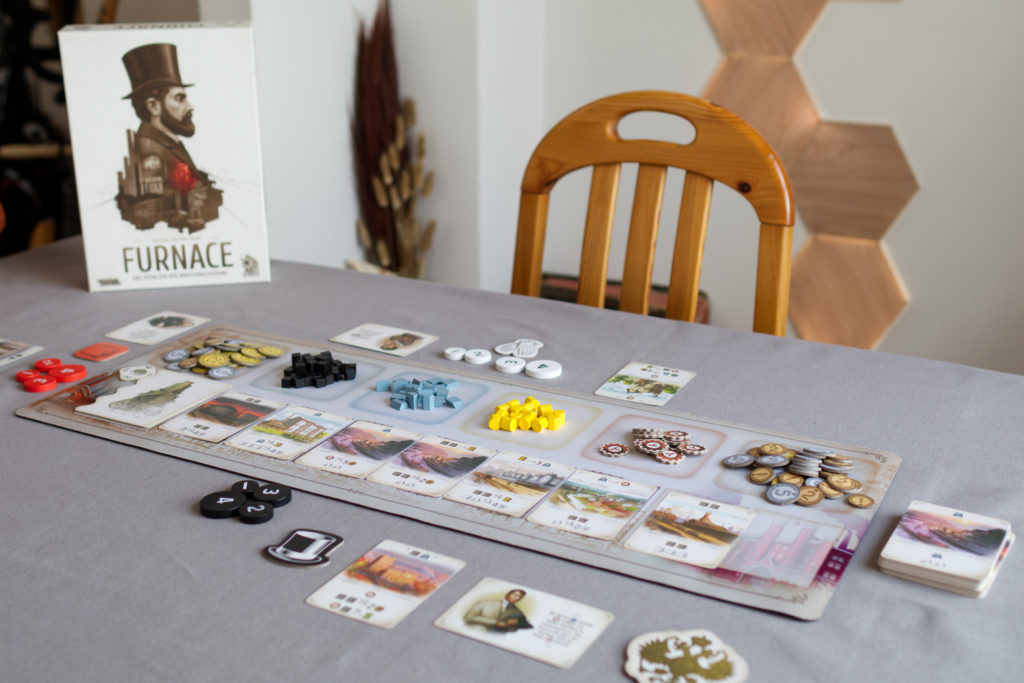
Setup
This is one of those games where setup is as brief as you hope for: dump the various resources on the table, into bowls or in my case on top of the optional playmat, take out the over-engineered but fun turn count marker, hand every player wooden disc from one to four in their player colour, a starting factory, a unique player power, decide on a starting player and your done. Shuffle the deck of factories, fill up the market with the number appropriate to your player count and you’re already way into the first of only four rounds.
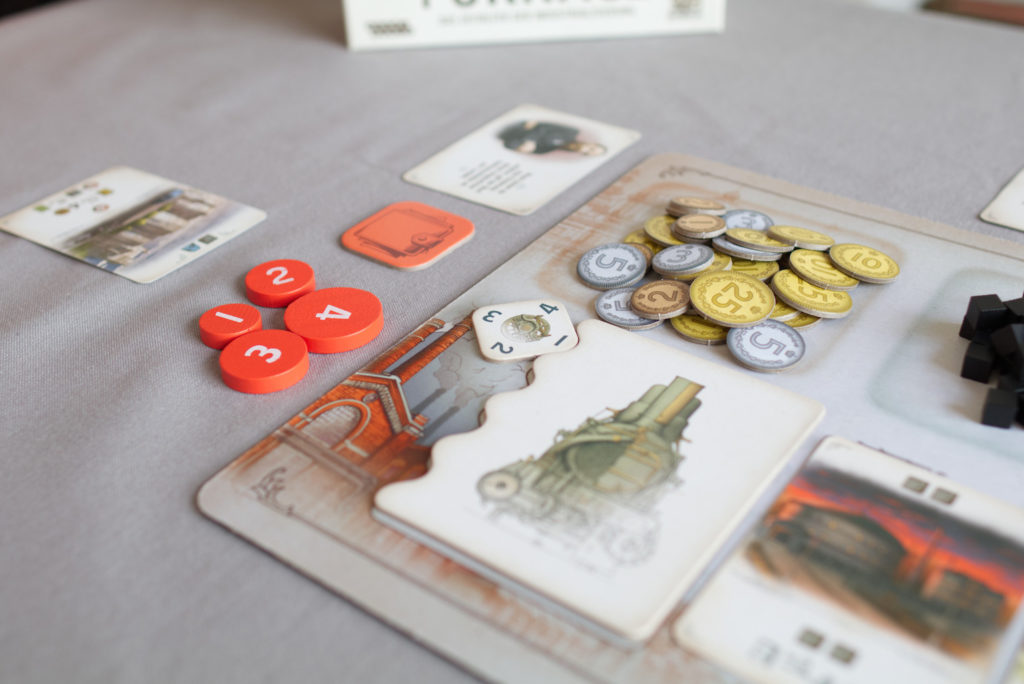
The Turn
When it’s your turn, pick one of your four discs and place it on any factory in the market. The only restrictions are that you are not allowed to place a disc such that there would be two discs with the same number (ensuring that there is always a clear winner) and no two discs of the same colour on any card. Note that you can place a number lower than the currently highest disc on a factory. This goes round clockwise until all discs are placed. It couldn’t be much easier.
But why should you place a disc on a certain card? Well, the player with the highest disc gets that factory and can add it to their growing collection of factories. So what happens to all lower bids? If you’re reading this, you’ve probably already heard about it because it is the main attraction of Furnace: every other player gets compensation for losing the bid for that auction! Each factory card has two parts: at the bottom is the functionality the owner of the factory can use in the later production phase. The top part shows the compensation when loosing the bid, either 1-2 resources or a conversion of resources. Take the compensation, multiply it with the number of your disc and you have your reward for loosing successfully. I’m phrasing it that way because often you want both: the resources and the production functionality, but you get only one. So while it is typically best to get as many factories as you can, there are situations where you desperately hope someone will pitch in a higher bid because you need the resources. And loosing a bid is the single biggest source of resources there is.
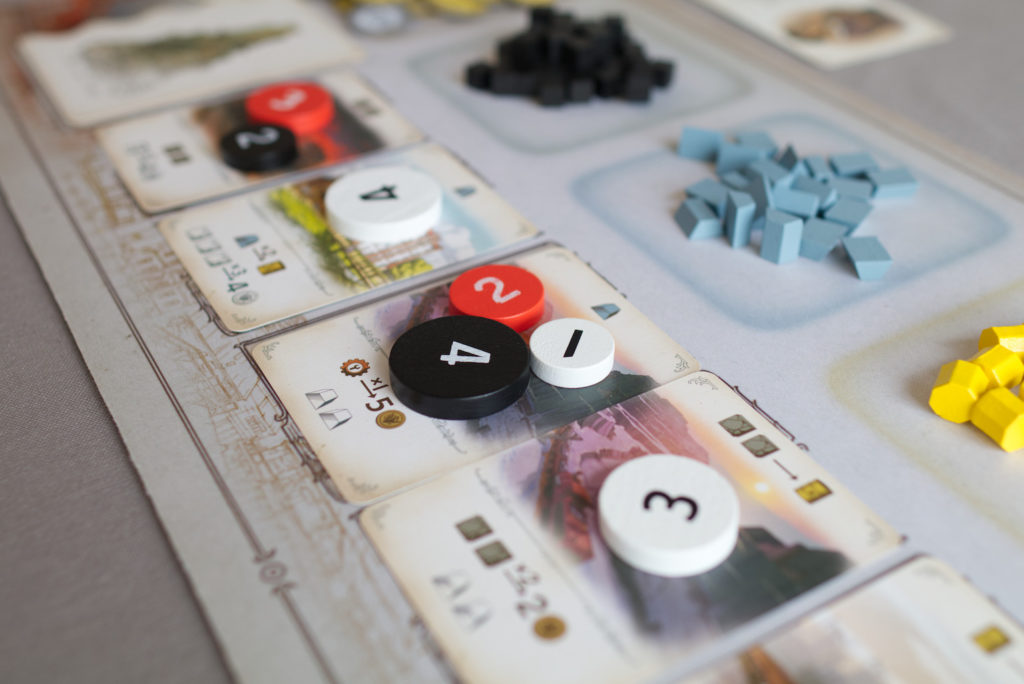
Production Phase
Once all factories have been auctioned off, the players take their new purchases and integrate them into their existing line of factories. There are two variants: either you’re allowed to change the order every turn – or – the order of existing factories cannot be changed but new purchases can be added at any point in that line. Once you’re done with that, your factories will one by one produce in the order you placed them. At that stage, the resources that might have been printed at the top of the card (to indicate the compensation) are completely irrelevant. Factories again give you either resources, let you convert them into other resources, or let you convert them into money. Money in this game has no function except as victory points.
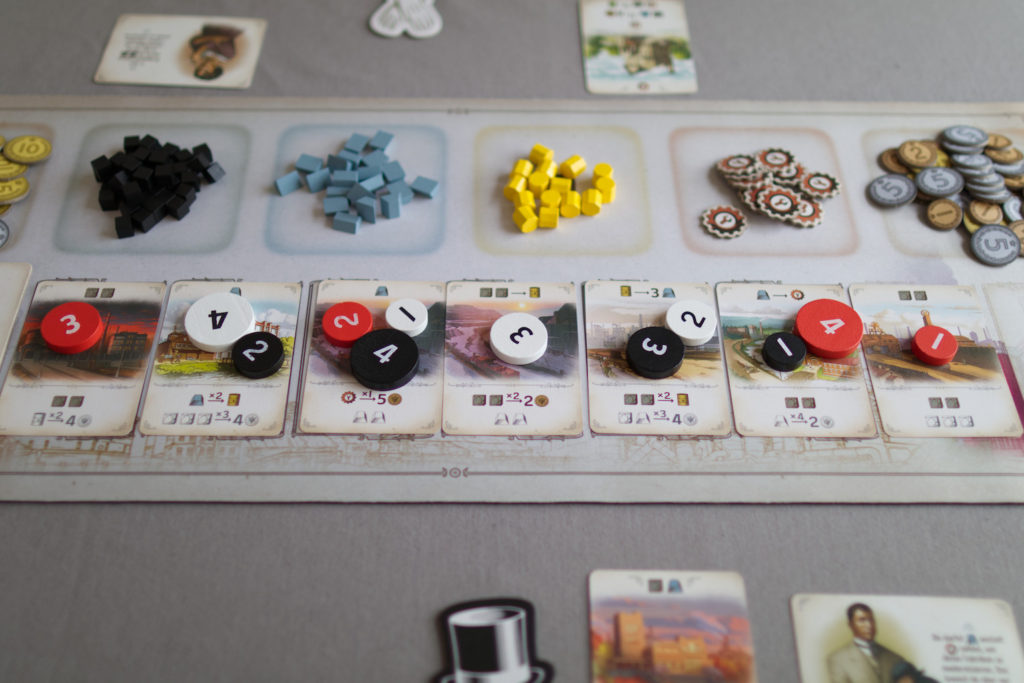
One important aspect is that each player starts of with a special starting factory, all of which are slightly different. They all give different starting resources but each produce one gear token that you can use with that factory to upgrade any other factory you own. All factories in the market have two sides: the normal side that shows the compensation at the top and some production part of it that is only shown as outlines. Upgrade the factory to flip it and the factory will now also give you that outlined effect.
End of Game
Repeat three more times: put new factories in the market, place discs, gain factories or compensations, produce. The player that earned the most money has been the most successful industrialist and wins. Yes, it’s that simple. The challenge is to figure out when to place what disc on what factory. Do you need to win the factory or rather lose with a high disc to get a fat compensation? You need to strategically lose auctions for resources so you can fuel your factories. On the other hand, you need your factories to refine your resources and ultimately convert to money. You can have the biggest pile of resources, but if you didn’t purchase the right factories to convert it into money, it has all been for nothing.
Variants, Player Count and Playmat
As I mentioned, there are two variants that differ in how restricted you are with your production line order. For two players, a simple automa in the form of a d6 die has been added to the box to help add at least a little bit of pressure when it comes to the market auctions. There is no official solo variant but Joseph Gea posted one on BGG that I tried 2-3 times and it works quite nicely. However, in my opinion Furnace only shines with 3 or 4 players. The most interesting part of it is playing the players, figuring out what’s in the market, what someone needs and if you need to place that one 4 you have now or later.
One thing to stress is that the playmat seen in the pictures is an optional extra. I lately am much more in favour of blinging out a game I like with a nice playmat and the quality of this one is really nice. However, you’re not missing out if you don’t get it. In fact, I felt it rather unnecessary and if I wouldn’t have gotten it in a package with the base game, I wouldn’t have bought it.
Conclusion
So far, this has been the shortest description I ever had to write for someone to get the basic feel of a game. Furnace isn’t complicated to learn because its complexity comes from the unusual bidding mechanism and the player interaction, the rules themselves are rather straight forward. This is nice because even casual players can play almost immediately, though most will take at least one play to really get a feel for how to squeeze the most money out of those four rounds of bidding.
Unfortunately, there is little there to get players to that second, third or fourth play. Yes, the artwork is lovely, but in the end you only care about the resource production/conversion on those cards. The bidding-compensation mechanism is clever but it seems to be more a curiosity that players want to experience once for themselves rather than something that makes them yearn for more. While aiming for loosing a bid to get resources is a great idea, it seems to be diluted because the factories themselves also produce resources. So it’s not a question IF you have to lose an auction or not but rather how you can get the most factories with an added resource boost. I’ve rarely had games where the player with the most factories didn’t also win (unless that player just bought completely disjointed stuff). Similarly, there are unique player powers which should spice up the game. But there are only five and none of them felt like I necessarily had to try the others. If they wouldn’t have been there, I wouldn’t have noticed.
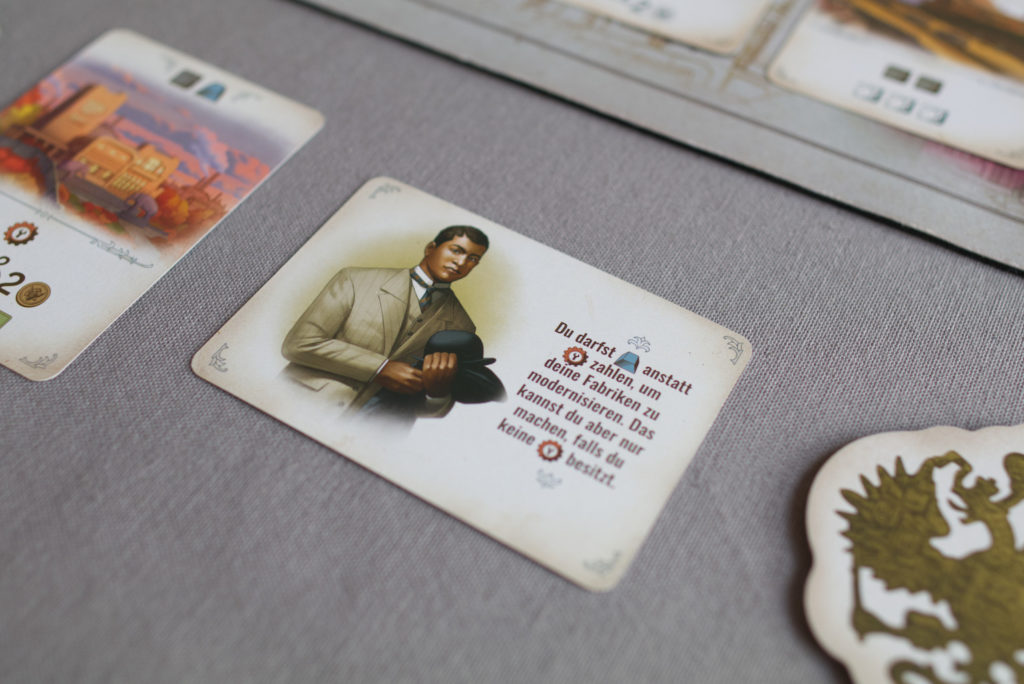
So coming back to the question in the beginning of this review, Furnace made me realise that the most important quality in a game – for me – is that I want to get back to it, over and over again. Furnace has the ingredients of a very good game but put together, the recipe seems to fall short. People liked it when we played it, which also explained why there was so much buzz about Furnace when it originally came out, but it mostly seemed to be the novelty of it that made the attraction.
Don’t get me wrong, I’m not necessarily looking for complexity here. Take one look at my battered copy of Coloretto, a game that is smaller, cheaper, yet still more refined, and you will see the dozens and dozens of plays I’ve gotten out of it. I’m also a big fan of Splendor, which compares nicely to Furnace in box size and price. It has a core mechanism that is strong and doesn’t get old for me. In contrast, the unique player powers and upgrading of factories in Furnace felt to me like being bolted on to an innovative but simple core bidding mechanism that isn’t strong enough to hold its own.
So my recommendation would be: try Furnace and try it with at least three players, ideally in a nice board game cafe! It’s a good production and has an interesting mechanism. In an ideal setting, placing a single disc can feel like a knife stab, either by you or against you. But whether it is enough to warrant repeated play heavily depends on what you and your play group are looking for.
